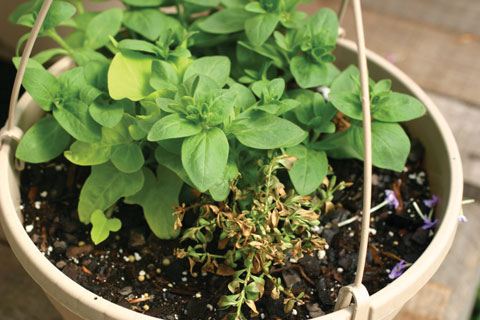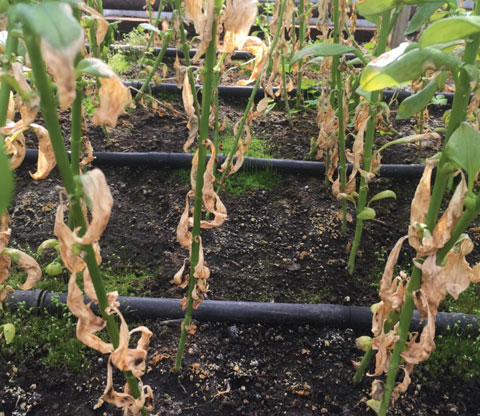2/1/2019
The Roads That Lead to Salty Water
Rosa E. Raudales & Ryan Dickson

The quality of irrigation water with respect to mineral composition affects the overall water use. When the concentration of salts is higher than plant uptake, residual salts accumulate in the root zone, resulting in unbalanced plant nutrition or runoff into the environment.
Salts in the water can be plant essential elements, like calcium, or non-essential elements, like sodium and chloride. The salinity status of the substrate is strongly related to the water source. In this article, we present a case study of a greenhouse in the northeastern U.S. dealing with high sodium and chloride concentrations in well water.
Figure 1. Example of greenhouse crops with phytotoxicity symptoms caused by high concentration of salts.
In northern states, salt used to de-ice roads in winter can leach and contaminate groundwater used for irrigation and affect crops in early spring. Road salt is often sourced from the natural mineral halite, a form of sodium chloride (NaCl). Researchers at the University of Massachusetts reported that well water in Massachu-setts’ greenhouses range between 1 and 544 ppm sodium, or 0.5 and 3,510 ppm chloride (https://goo.gl/bGQF1v). The maximum concentrations recommended for most container crops are ~50 ppm sodium and 100 ppm chloride (values may be lower for seedlings and salt-sensitive crops). Excessive sodium and chloride in the irrigation water can lead to build-up of salts in the root zone, interfere with nutrient uptake by roots and cause toxicity as shown in Figure 1.
An experienced grower faces a new problem
Description of the problem: An experienced greenhouse grower in Connecticut observed marginal leaf yellowing and necrosis (scorched and crispy leaf tissue) in several spring container crops. The preceding summer, the grower conducted complete nutrient analyses of the water of all the wells in their company and developed nutrient programs to match water quality. The company has multiple greenhouse locations where the head grower implements the same cropping recommendations, including fertilization regime. However, symptoms did not appear across greenhouses and were observed only in one location.
The growers’ fertigation program consisted of irrigating with low nutrient levels with every irrigation and keeping the substrate on the dry side. Inspection of the fertilizer injectors and rates ruled out equipment failure and mixing error as possibilities.
Substrate and tissue samples from two greenhouse locations (Locations A and B) were sent to a laboratory for nutrient analysis. Samples from Location A were from healthy-looking plants, which served as a control, and samples from Location B were from symptomatic plants of the same species.
S odium and chloride concentrations in the substrate were very high in both samples, but much higher at Location B where the toxicity symptoms were visible (Table 1). Sodium in plant tissue at Location B was twice as high compared with Location A (chloride in tissue wasn’t measured). A follow-up irrigation water test also indicated that sodium and chloride were at 50 and 120 ppm for Locations A and B, which was greater than the previous summer.
odium and chloride concentrations in the substrate were very high in both samples, but much higher at Location B where the toxicity symptoms were visible (Table 1). Sodium in plant tissue at Location B was twice as high compared with Location A (chloride in tissue wasn’t measured). A follow-up irrigation water test also indicated that sodium and chloride were at 50 and 120 ppm for Locations A and B, which was greater than the previous summer.
The cause: Sodium and chloride levels had increased in the irrigation water, particularly at Location B, causing plant toxicity symptoms. It wasn’t possible to trace the specific source. However, sodium and chloride can increase in groundwater during winter and early spring from leaching of road salt. Sodium and chloride can also contaminate groundwater in other ways, for example, seawater intrusion is common for growers in coastal regions.
Alternatives to managing high sodium in your water source
• Use alternative water sources. Growers should first consider using an alternative water source that’s low in salts—a more pure water source. The quality of ground or surface water may differ by individual units even within the same property, hence, the importance of testing each water source independently.
In some areas, growers can switch to public water sources. While the cost of highly treated water may be high, it reduces the burden on growers and the risks of crop loss. Growers must adjust their fertilization regime to match the quality of the new water sources.
(In this case study, the grower did not have access to an alternative water source.)
• Treat the water. Ultrafine membrane filtration, like reverse osmosis, is an effective alternative to remove salts from irrigation water. Reverse osmosis can remove all the dissolved salts, except boron, from the irrigation water. This technology is effective, but it’s costly and requires highly trained operators.
(In this case study, the grower considered setting a reverse osmosis system in the operation. However, they didn’t want to rush the decision or establish a new, complex system in the middle of the season.)
• Adjust fertigation program. Increasing the leaching fraction is a common practice to wash away the salts from the substrate. Leaching also washes away nutrients, therefore, it may require increasing fertilizer rate. Growers can also increase the fertilizer rate as a strategy to displace non-essential salts. For example, calcium has a positive charge and competes with the positive charges of sodium, displacing sodium from the substrate and preventing sodium uptake.
 Figure 2. Lower leaf burn and necrosis in snapdragon cut flowers resulting from sodium toxicity.
Figure 2. Lower leaf burn and necrosis in snapdragon cut flowers resulting from sodium toxicity.
(In this case study, the grower implemented this alternative because it was a simple and immediate option. They changed the fertilization program and increased calcium from 150 to 250 ppm. They also increased the leaching fraction.)
This option worked in this scenario because the problem was temporary and sodium in the water source decreased over time. Salt levels usually decrease after aquifers recharge from snowmelt and rainfall later in the season. However, this option may not be applicable to all situations. Crops with advanced salt-toxicity symptoms may not recover and increasing the EC may aggravate the symptoms.
It’s also important to point out that increasing total EC of the nutrient solution isn’t an option for salt-sensitive crops, like New Guinea impatiens, or young plants. Flood floor and sub-irrigation benches are essentially no-leach irrigation systems and are therefore more sensitive to salt accumulation in the growing substrate.
Take-home messages
1. Test water quality frequently. The grower proactively tested the water the preceding summer. However, salt contamination most likely occurred during the winter months. Other growers reported high sodium levels during the summer in years with moderate to severe drought.
In New England, we have observed that with sufficient snowmelt and rainfall the aquifers replenish, and sodium and chloride concentrations drop to acceptable values. In this case study, the grower had the funds to purchase a reverse osmosis system. They decided to start with something simple and practical, and monitor the problem overtime. Since the problem didn’t persist, they avoided the cost of buying and maintaining complicated equipment.
Growers should test the irrigation water source at least twice in the year. In the presence of problems, continuous monitoring will help make informed decisions and avoid unnecessary costs.
(Use WaterQual to help you interpret the reports of water testing: www.cleanwater3.org/wqi.asp.)
2. Adjust fertigation to current needs. The grower applied low fertilization and water rates to the substrate as a good cropping practice to control height and prevent root rot. In general, sodium and chloride uptake increases with low fertilization levels and accumulates more in the substrate when there’s little leaching fraction, augmenting sodium damage. Under these specific circumstances, increasing fertilization and leaching irrigation rate helped prevent crop loss.
Growers who proactively test water quality and monitor nutrient solutions are better prepared to prevent nutrient disorders and crop loss. GT
Rosa Raudales (rosa@uconn.edu) is an assistant professor in plant science at the University of Connecticut. Ryan Dickson is an assistant professor in horticulture at the University of Arkansas.